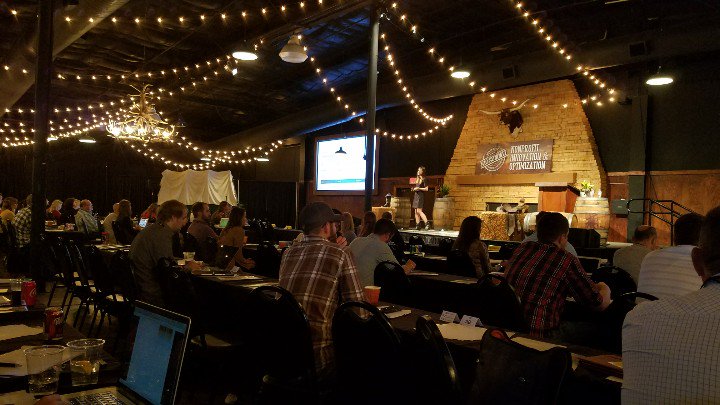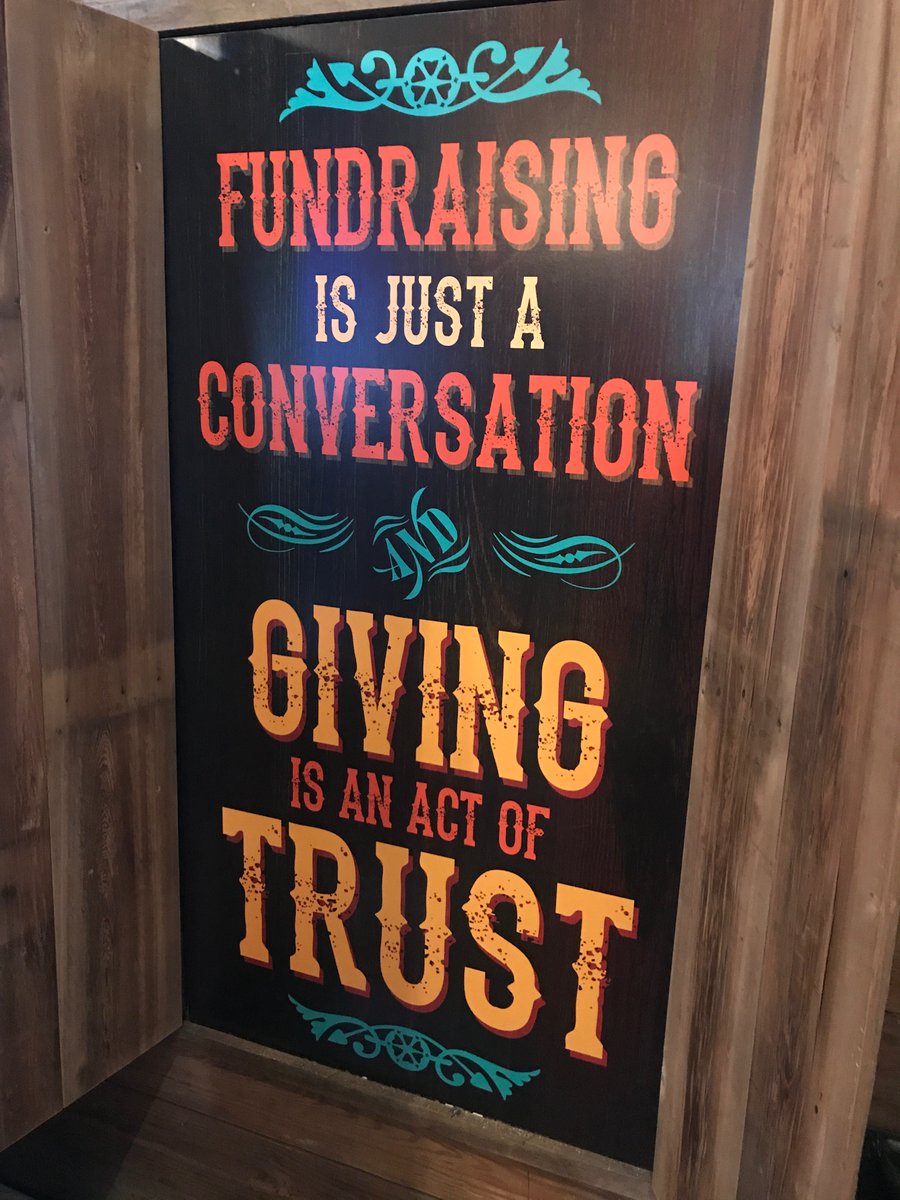This week I was speaking at the Non-profit Innovation and Optimization Summit (NIO Summit) in Fort Worth, Texas. It’s run by the amazing team behind Next After whose aim is to help non-profits attract and convert more donors by ‘turning the web into a living laboratory.’


Next After invest in a lot of research and testing to uncover what’s working in the world of driving non-profit donations. I attended their inaugural summit last year and had the good fortune of being asked to speak again this year.
This video sums up just how much fun this event is. (Watch out for my bull-riding prowess)
My talk looked at how easy it is to become disconnected to your target market when we write copy. Despite being driven by a desire to attract, engage and convert ideal prospects, things can get in the way when filling the blank page with a marketing message.
One such thing is forgetting to give prospects a taste of the experience you’re asking them to accept.
Let people try before they buy (without giving everything away)
Whether your call-to-action is to sign-up for a webinar, phone your office, join a course, buy, register for your newsletter, there is some kind of experience waiting for your audience. It’s easy to focus on the call-to-action as the end result, but really you want your prospect looking beyond that. You want them to anticipate and feel invested in whatever it is you’re asking them to commit to.
When your audience is being bombarded with demands on their time and attention, you’ve got to work hard to sell what you have, even if you’re giving something away for free.
But it can be hard to think that every time you sit down to write something, you’ve got to ‘sell’ it. So I created a four-part, simple prompt to help you focus on the key levers for moving your audience.
What’s more, it rhymes. Which is important for helping things stick. Just ask Dr. Seuss.
Here we go…
- What’s new?
- Says who?
- Give me 2 (or 3)
- So I can do…
Let’s break this down using an example I walked through at the NIOSummit. I picked a non-profit organisation, in this instance, Friends of the Earth. One of their campaigns is to prevent the decline in bee numbers.
Let’s imagine we want people to download our information pack. Some typical copy might be:
Download our information pack and see how you can help save bees.
Now, let’s apply the four-part system above to see if we can sell it by giving our potential donor a peek inside.
1. What’s new?
People read and watch the news to stay updated not missing developments in their areas of interest. One thing you can do in your copy is ask yourself, why is what you have relevant, and indeed necessary in today’s world. What’s new? What is happening that your audience may not know about.
In our bee example, we could think about what donors may not know about this cause. People may not know how integral bees are not only to the pollination of flowers, but our food, drink and even clothes. They may not realise the severity of the situation, or what’s about to happen that could impact the cause. For example:
Bees pollinate much of the food in our diets from apples to coffee. Even cotton clothing is possible because the cotton plant was pollinated.
But they’re in danger and some species face extinction.
The UK government and the EU are about to make key decisions that could make the situation worse.
You may need to do some digging and research what’s happening in your industry, but if you can tie what you have to current affairs that your reader cares about, you’re elevating what you have to a newsworthy standard.
Next, we have:
2. Says who?
I like to think of this in 2 parts:
- Who are you?
- Who do you help?
Give your audience a little bit about who you are and what makes you qualified to make your offer, and also provide a glimpse into the lives of people you have helped. This may be through testimonials, or awards, reviews, case studies etc. For our bee campaign we may want to outline previous campaigns, or share testimonials from people who have previously downloaded and enjoyed our information pack.
At Friends of the Earth, we’ve saved areas of natural beauty from destruction, raised money for flood defences and more.
And we’ve do this by working with donors like you.
“The children were so engaged by the materials. Learning about bees is a fantastic classroom project” A. Teacher.
3. Give me 2 (or 3)
This is where my rhyming abilities were tested. I would usually lean towards three, but if two means you’re more likely to remember this step, that’s a bigger pay off.
This is about giving your reader a handful of discoveries, key takeaways or points that they will learn by engaging with you. It ties into making your message ‘new’. People won’t engage or take action if they think they already know what you want to tell them.
When writing these, you want to keep some of the information back, for example:
- Revealed: The national garden centres now banning pesticides that harm bees
- See how to make a ‘bee hotel’ in your garden or school
- Get your ethical guide to buying honey that keeps bees healthy and happy
If you have a gardening enthusiast, they may want to know which garden centres are taking the bee problem seriously. A teacher may be intrigued by the bee hotel as a classroom project, and an ethical shopper may want to avoid doing anything that could make the bee problem worse.
Always try and prompt yourself to think what are the 2-3 key takeaway points my reader or customer will learn (hint: it has to be something they care about of course!)
This leads subtly into the final part which is…
4. So I can do…
This final part encourages you to include the impact of what you have to offer. If your audience takes your call-to-action, what can they do that they couldn’t do before?
If you have a newsletter, you don’t want to just say ‘sign up and get the latest news’ – ask yourself what your reader can do with that news.
- Can they find out about events they care about in advance?
- Can they make better decisions?
- Can they save or make money with your advice?
- Can they save time by following your advice?
Asking the simple question – what can my audience do with my offer makes it more likely that you will write copy that focuses on a transformation, not a transaction. With our bee example, it might be:
- Reverse the bee decline and be part of the generation that saves bees
- Transform your garden into a bee-friendly haven
This encourages your reader to think further than clicking a button and anticipate the impact you can offer them.
I’d love to know how you sell the experience of your offers, whether free or paid. And hopefully this four-part narrative can keep you focused.
Let me know in the comments below and in the meantime, enjoy me rocking the mechanical bull at the NIO Summit party:


This is super. Rhymes brighten the content creation. Thanks.
Thanks Dawn! They can definitely help make things stick in the mind a little more. 🙂
Hi, Amy!
Part of me is most jealous of your globetrotting adventures. The other is happy to not be suffering from jet-lag and puffy ankles.
Thank you as always for the terrific copywriting advice and living a life for me to be envious of…in a good way.
Looking forward to the day when I can be in the live audience. Even closer to hand, looking forward to what you’ve got in store for us next month on the new website.
Cheers!
Hey Lori!
I’m very lucky to have the opportunity to travel and meet some fantastic people, and equally, I love coming home and enjoying my creature comforts. 🙂
Can’t wait to see you in the audience one day Lori – I know you’ll get there!
In the next few weeks I enter small business health insurance world. So instead of call me, or email me, give more of What’s new with Obamacare, we’re Largely health, an independent broker? Then something new and the what they can do? Little tougher but I get your meaning. Thanks for the article.
Hey Joe! Thanks for commenting, and great to hear about your new venture.
As an independent broker, it may be that what people can ‘do’ is access more choice and information about what’s available to them. In turn, this means they can cut through confusion and not only find a simpler path to heath insurance, but one they can feel confident about, knowing that they have the best fit for their unique circumstances. These are just off the top of my head without knowing exactly how you work. But if you can find an angle for new, and show the impact of your service (by showing people what they can ‘do’) you’re zeroing in on that valuable customer perspective.
Thanks for commenting!